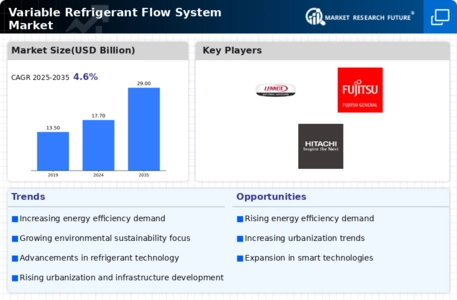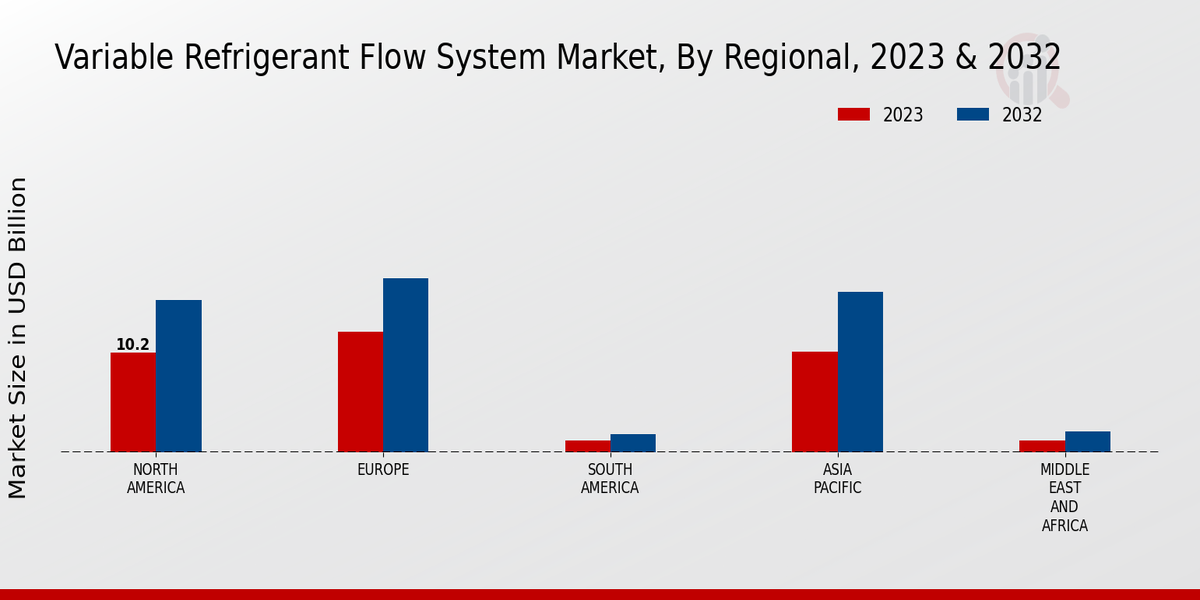Market Growth Projections
The Global Variable Refrigerant Flow System Market Industry is projected to experience substantial growth over the coming years. With an estimated market value of 17.7 USD Billion in 2024, the industry is on track to reach 29.0 USD Billion by 2035. This growth trajectory reflects a compound annual growth rate of 4.59% from 2025 to 2035. The increasing adoption of energy-efficient technologies, coupled with advancements in HVAC systems, is likely to drive this expansion. As the market evolves, it will be essential for stakeholders to stay informed about emerging trends and technologies to capitalize on the opportunities presented.
Regulatory Support and Incentives
Regulatory frameworks and incentives are playing a pivotal role in shaping the Global Variable Refrigerant Flow System Market Industry. Governments are increasingly offering financial incentives for the adoption of energy-efficient technologies, including VRF systems. These policies not only encourage investment in advanced HVAC solutions but also promote sustainability initiatives. As regulatory support continues to strengthen, it is expected that more businesses and homeowners will opt for VRF systems, further driving market growth. The combination of regulatory backing and financial incentives is likely to create a favorable environment for the expansion of the VRF market.
Rising Awareness of Indoor Air Quality
The Global Variable Refrigerant Flow System Market Industry is also influenced by the growing awareness of indoor air quality. As individuals become more conscious of the health implications associated with poor air quality, the demand for HVAC systems that provide better air filtration and temperature control is increasing. VRF systems, with their ability to maintain consistent indoor climates, are well-positioned to meet these needs. This heightened focus on indoor air quality is likely to drive market growth, as consumers and businesses prioritize systems that enhance comfort and well-being in indoor environments.
Increasing Demand for Energy Efficiency
The Global Variable Refrigerant Flow System Market Industry is experiencing a surge in demand driven by the increasing emphasis on energy efficiency. As governments worldwide implement stricter energy regulations, businesses and homeowners are seeking HVAC solutions that reduce energy consumption. Variable Refrigerant Flow systems, known for their ability to adjust refrigerant flow based on demand, provide a compelling solution. This trend is reflected in the projected market growth, with the industry expected to reach 17.7 USD Billion in 2024 and potentially 29.0 USD Billion by 2035, indicating a robust shift towards energy-efficient technologies.
Technological Advancements in HVAC Systems
Technological innovations are propelling the Global Variable Refrigerant Flow System Market Industry forward. The integration of smart technologies, such as IoT and advanced control systems, enhances the operational efficiency of VRF systems. These advancements allow for real-time monitoring and optimization of HVAC performance, which could lead to significant energy savings. As a result, the market is likely to witness a compound annual growth rate of 4.59% from 2025 to 2035. The continuous evolution of technology in HVAC systems is expected to attract investments and drive further adoption of VRF systems across various sectors.
Growing Urbanization and Infrastructure Development
Urbanization is a key driver of the Global Variable Refrigerant Flow System Market Industry. As cities expand and infrastructure develops, the demand for efficient HVAC systems increases. Urban areas often face challenges related to space and energy consumption, making VRF systems an attractive option due to their compact design and zoning capabilities. This trend is particularly evident in emerging economies, where rapid urban growth necessitates innovative solutions. The market's growth trajectory suggests that VRF systems will play a crucial role in meeting the HVAC needs of urban environments, thereby contributing to the industry's overall expansion.














